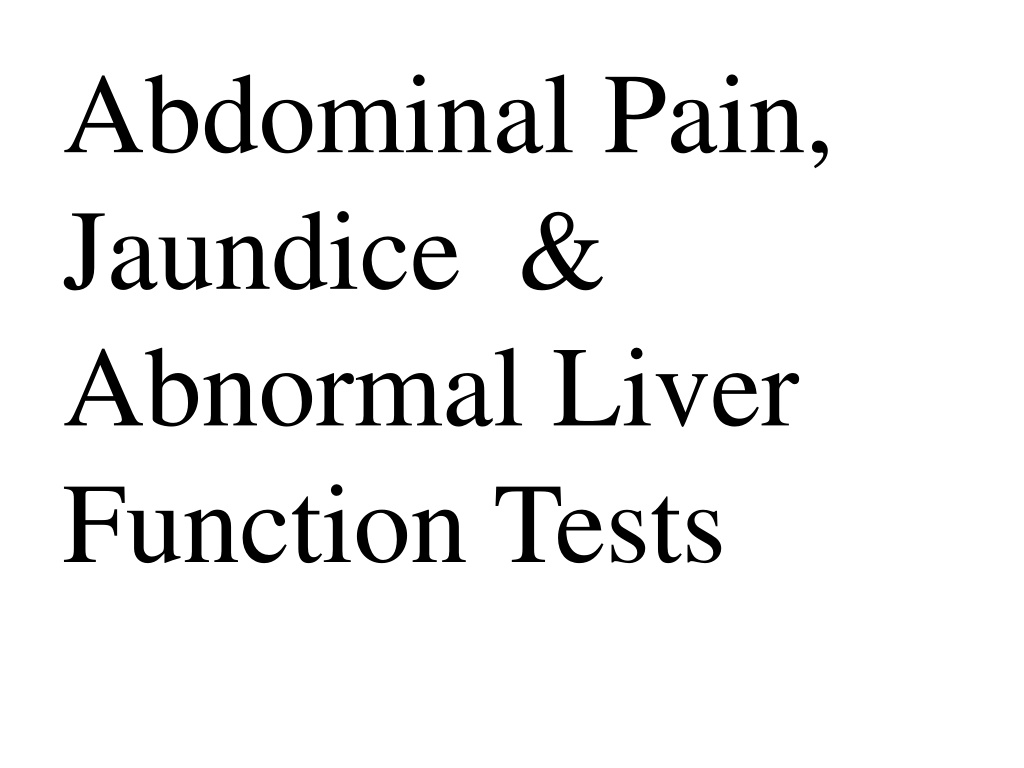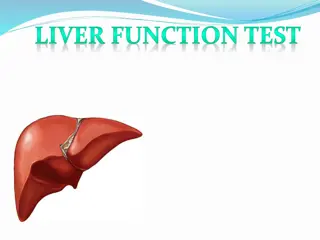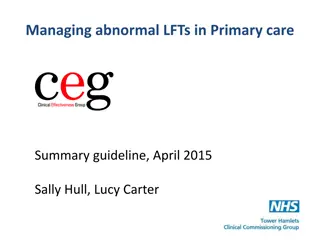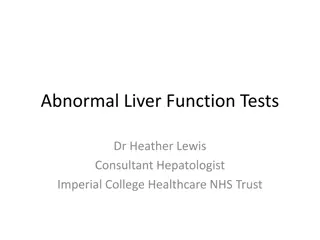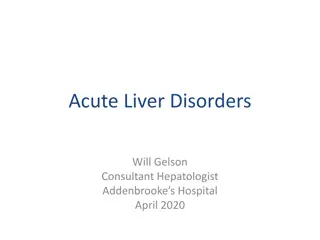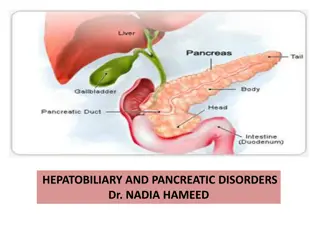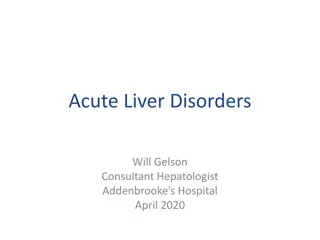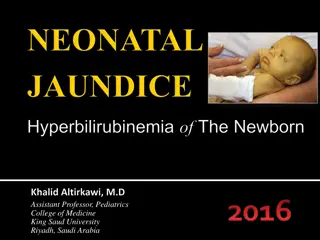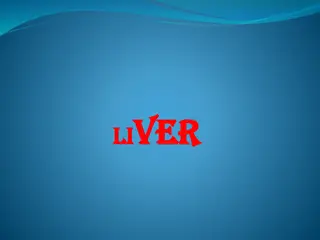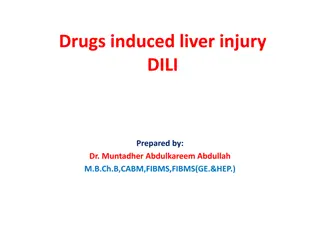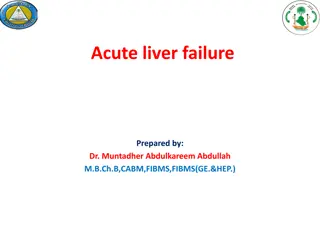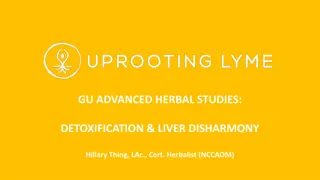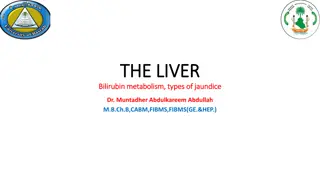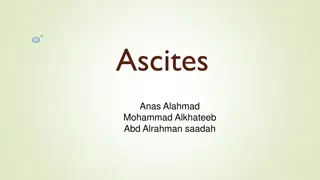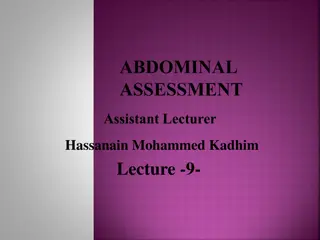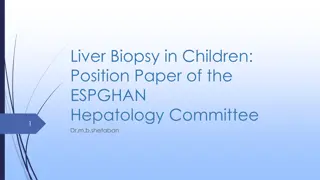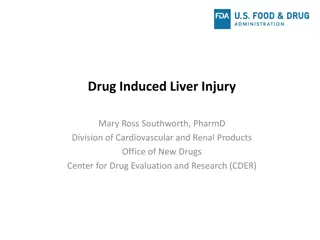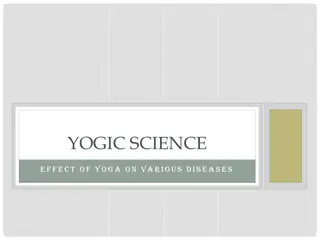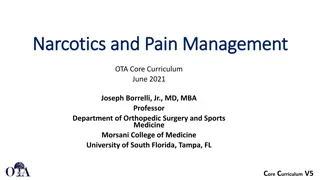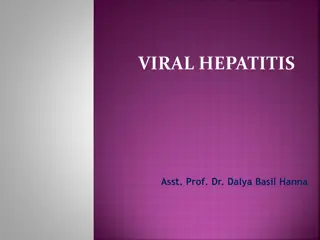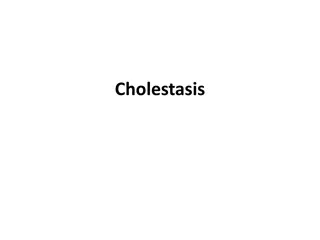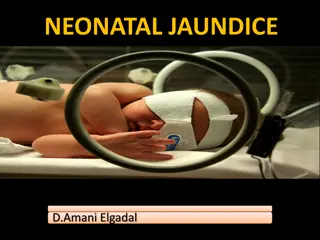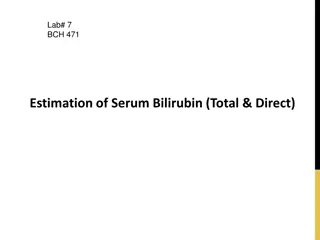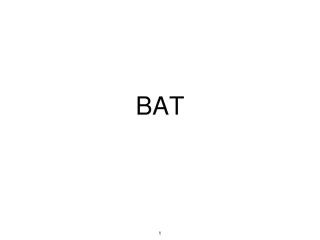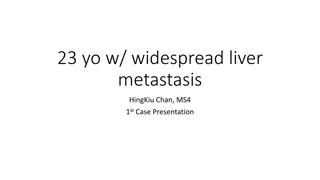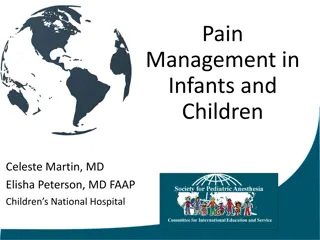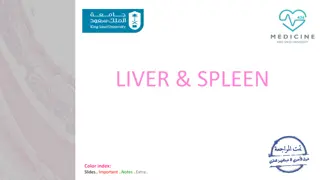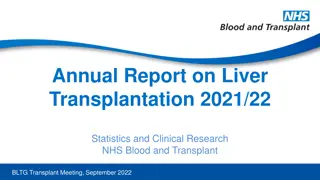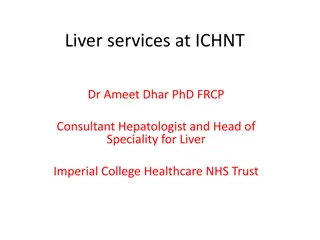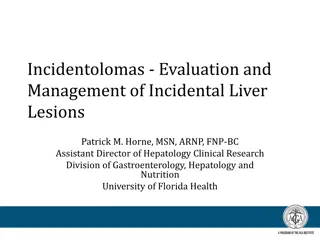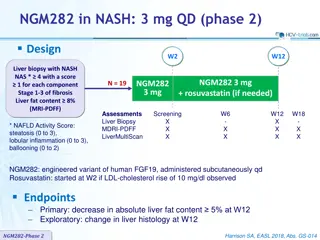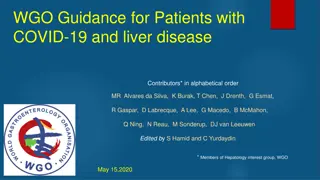Abdominal Pain, Jaundice & Abnormal Liver Function Tests in an 8-Year-Old Boy
An 8-year-old boy presents with intermittent abdominal pain that occurs before breakfast and sometimes at school, relieved by activities. He also exhibits jaundice and abnormal liver function tests, indicating a potential underlying liver issue. Immediate medical evaluation is necessary to diagnose and treat the root cause of his symptoms.
Download Presentation

Please find below an Image/Link to download the presentation.
The content on the website is provided AS IS for your information and personal use only. It may not be sold, licensed, or shared on other websites without obtaining consent from the author. Download presentation by click this link. If you encounter any issues during the download, it is possible that the publisher has removed the file from their server.
E N D
Presentation Transcript
Abdominal Pain, Jaundice & Abnormal Liver Function Tests
An 8-year-old boy presents with three days history of abdominal pain lasting ~20 min. It occurs before breakfast & sometimes at school, where it will generally pass when he busies himself with activities. He has a tendency to constipation. His pains worsen when faced with tests at school or other stressors. Exam is normal.
What Are The Signs &Symptoms Of ORGANIC Abdominal Pain?
Alarm features suggesting organic causes 1-Symptoms -Persistent RU or LQ pain -Pain causing nocturnal waking -Dysphagia or persistent vomiting -Nocturnal diarrhea -GI blood loss -FHx of IBD,CD,PUD 2-Signs -Unexplained fever -Wt loss or deceleration of linear growth , delayed puberty -Arthritis -Perianal disease
Diagnostic Approach to Acute Abdominal Pain History Onset Sudden or gradual, prior episodes, association with meals, Hx of injury Nature Sharp versus dull, colicky or constant, burning Location Epigastric, periumbilical, generalized, Rt or Lt lower quadrant, change in location over time Fever Presence suggests appendicitis or other infection Extra-intestinal symptoms Cough, dyspnea, dysuria, urinary frequency, flank pain Course of symptoms Worsening or improving, change in nature or location of pain. Physical Exam. General growth & nutrition, general appearance, hydration, degree of discomfort, body position Abdominal tenderness, distention, bowel sounds, rigidity, guarding, mass Genitalia Testicular torsion, hernia, PID, ectopic pregnancy Surrounding structures Breath sounds, rales, rhonchi, wheezing, flank tenderness, tenderness of abdominal wall structures, ribs, costochondral joints PR exam. Perianal lesions, stricture, tenderness, fecal impaction, blood Laboratory CBC, CRP, ESR Evidence of infection or inflammation AST, ALT, GGT, bilirubin Biliary or liver disease .Amylase, lipase Pancreatitis. GUE UTI , bleeding due to stone, trauma, or obstruction Pregnancy test (older females) Ectopic pregnancy . Radiology Plain flat & upright abdominal films Bowel obstruction, appendiceal fecalith, free intraperitoneal air, Renal stones . CT scan Rule out abscess, appendicitis, Crohn disease, pancreatitis, gallstones, renal stones .Ba. enema Intussusception, malrotation U\S Gallstones, appendicitis, intussusception, pancreatitis, Renal stones Endoscopy Upper endoscopy Suspected peptic ulcer or esophagitis
Disease Functional: irritable bowel syndrome Onset Recurrent Location Periumbilical, splenic and hepatic flexures Referral None Quality Dull, crampy, intermittent; duration 2 hr Comments Family stress, school phobia, diarrhea & constipation; hypersensitive to pain from distention Sour taste in mouth; Sandifer syndrome Esophageal reflux Recurrent, after Substernal Chest Burning meals, at bedtime Recurrent, before meals, at night Duodenal ulcer Epigastric Back Severe burning, gnawing Relieved by food, milk, antacids; family history important; GI bleeding Nausea, emesis, marked tenderness Distention, obstipation, bilious emesis, increased bowel sounds Nausea, emesis, local tenderness, fever, avoids motion Hematochezia; painless unless intussusception, diverticulitis, or perforation Pancreatitis Acute Epigastric-hypogastric Back Constant, sharp, boring Intestinal obstruction Acute or gradual Periumbilical-lower abdomen Back Alternating cramping (colic) and painless periods Sharp, steady Appendicitis Acute Periumbilical or epigastric; localizes to right lower quadrant Periumbilical-lower abdomen Back or pelvis if retrocecal Meckel diverticulum Recurrent None Sharp Inflammatory bowel disease Intussusception Recurrent Depends on site of involvement Periumbilical-lower abdomen Dull cramping, tenesmus Fever, weight loss, hematochezia Guarded position with knees pulled up, currant jelly stools, lethargy Distention, gaseousness, diarrhea Hematuria Fever, costochondral tenderness, dysuria, urinary frequency, emesis Hemolysis jaundice, nausea, emesis Acute None Cramping, with painless periods Lactose intolerance Urolithiasis Pyelonephritis Recurrent with milk products Acute, sudden Acute, sudden Lower abdomen None Cramping Back Back Groin None Severe, colicky pain Dull to sharp Cholecystitis and cholelithiasis Acute Right upper quadrant Right shoulder Severe, colicky pain
Comparison of Crohn Disease & Ulcerative Colitis Feature Malaise, fever, weight loss Rectal bleeding Abdominal mass Abdominal pain Perianal disease Ileal involvement Strictures Fistula Skip lesions Transmural involvement Crypt abscesses Intestinal granulomas Risk of cancer Erythema nodosum Mouth ulceration Osteopenia at onset Autoimmune hepatitis Sclerosing cholangitis Crohn Disease Common Sometimes Common Common Common Common Common Common Common Usual Variable Common Increased Common Common Yes Rare Rare Ulcerative Colitis Common Usual Rare Common Rare None (backwash ileitis) Unusual Very rare Not present Not present Usual Rarely present Greatly increased Less common Rare No Yes Yes
Diagnostic Studies for Inflammatory Bowel Disease Interpretation Studies Blood Tests CBC with WBC differential ESR C-reactive protein ASCA Atypical p-ANCA Anti-OmpC Imaging Studies Upper GI series with SBFT CT scan Tagged WBC scan Endoscopy Upper endoscopy Anemia, elevated platelets suggest IBD Elevated in many, but not all, IBD patients Elevated in many, but not all, IBD patients Found in most CD patients and few UC patients Found in most UC patients and few CD patients Found in some UC and CD patients, rare in non-IBD Essential to rule out ileal & jejunal CD Used to detect abscess, small bowel involvement Sometimes helpful in determining extent of disease Evaluate for CD of esophagus, stomach, & duodenum; obtain tissue for histological Dx Colonoscopy Show presence or absence of colitis & terminal ileal CD; obtain tissue for histology Capsule endoscopy Emerging role in Dx of small bowel CD, more sensitive than upper GI series with SBFT Anti-OmpC, antibody to outer membrane protein C; ASCA, anti-Saccharomycescerevisiae antibody; atypical p- ANCA, atypical perinuclear staining by antineutrophil cytoplasmic antibody; CBC, complete blood count; CD, Crohn disease; ESR, erythrocyte sedimentation rate; GI, gastrointestinal; IBD, inflammatory bowel disease; SBFT, small bowel follow-through; WBC, white blood cell
FEATURES OF THE HEPATOTROPIC VIRUSES VIROLOGY HAV RNA HBV DNA HCV RNA HDV RNA HEV RNA 19 - 15 180 - 60 160 - 14 42 - 21 63 - 21 Incubation (days) Transmission Parenteral Rare Yes Yes Yes No Fecal-oral Yes No No No Yes Sexual No Yes Yes Yes No Perinatal No Yes Rare Yes No Chronic infection No Yes Yes Yes No Fulminant disease Rare Yes Rare Yes Yes
DIAGNOSTIC BLOOD TESTS: SEROLOGY AND VIRAL PCR HAV ACUTE INFECTION HBV HCV HDV HEV Anti-HAV IgM Anti-HBc IgM Anti-HCV Anti-HDV IgM Anti-HEV IgM HBsAg Anti-HBs HBV DNA (PCR) Blood PCR positive HBsAg Anti-HBs Blood PCR positive HCV RNA (PCR) Blood PCR positive PAST INFECTION (RECOVERED) Anti-HCV Blood PCR negative Anti-HDV IgG Blood PCR negative Anti-HEV IgG Blood PCR negative Anti-HBs Anti-HBc IgG Anti-HAV IgG CHRONIC INFECTION Anti-HBc IgG HBsAg+ Anti-HBs PCR positive or negative Anti-HDV IgG Blood PCR negative HBsAg+ Anti-HCV Blood PCR positive N/A N/A VACCINE RESPONSE Anti-HBs Anti-HBc Anti-HAV IgG N/A N/A N/A Rises in serum levels of ALT, AST, bilirubin, ALP, 5 -nucleotidase, and GGT are almost universally found and do not help to differentiate the cause of hepatitis
The serologic course of acute hepatitis A. ALT, alanine aminotransferase; HAV, hepatitis A virus. (From Goldman L, Ausiello D: Cecil textbook of medicine, ed 22, Philadelphia, 2004, Saunders, p 913.)
The serologic course of acute hepatitis B. HBc, hepatitis B core; HBeAg, hepatitis B e antigen; HBs, hepatitis B surface; HBsAg, hepatitis B surface antigen; HBV, hepatitis B virus; PCR, polymerase chain reaction. (From Goldman L, Ausiello D: Cecil textbook of medicine, ed 22, Philadelphia, 2004, Saunders, p 914.)
The serologic course of acute hepatitis C. ALT, alanine aminotransferase; HCV, hepatitis C virus; PCR, polymerase chain reaction. (From Goldman L, Ausiello D: Cecil textbook of medicine, ed 22, Philadelphia, 2004, Saunders, p 915.)
Natural history of hepatitis B virus infection. HCC, hepatocellular carcinoma; OLT, orthotopic liver transplant
INDICATIONS AND DOSING SCHEDULE FOR HEPATITIS B VACCINE AND HEPATITIS B IMMUNOGLOBULIN VACCINE DOSE SCHEDULE RecombivaxHB ( g) Engerix-B ( g) UNIVERSAL PROPHYLAXIS Infants of HBsAg women 5 5 10 10 Birth, 1-2, 6-18 mo 0, 1, and 6 mo Children & adolescents (11-19 yr) POSTEXPOSURE PROPHYLAXIS IN SUSCEPTIBLE INDIVIDUALS Contact with HBsAg-Positive Source Infants of HBsAg+women 5 Intimate or Identifiable Blood Exposure 0-19 yr old 5 10 Household 0-19 yr old 5 >19 yr old 10 Casual None Immunocompromised] 40 Contact with Unknown HBsAg Status; Intimate or Identifiable Blood Exposure >19 yr old 10 Immunocompromised[ ] 40 10 Birth* (+HBIG[ ]), 1 and 6 mo 10 20 Exposure (+HBIG[ ]), 1 and 6 mo Exposure (+HBIG[ ]), 1 and 6 mo >19 yr old 10 20 None 40 Exposure, 1 and 6 mo Exposure, 1 and 6 mo None Exposure (+HBIG[ ]), 1 and 6 mo 20 40 Exposure, 1 and 6 mo Exposure (+HBIG[ ]), 1 and 6 mo Both HBIG & vaccine should be administered within 12 hr of the infant's birth & within 24 hr of identifiable blood exposure. HBIG ,HBIG dose: 0.5 L for newborns of HBsAg-positive mothers, and 0.0 6 L/kg for all others when recommended be given up to 14 days after sexual exposure Seroconversion status of immunocompromised patients should be checked 1-2 mo after the last dose of vaccine, and yearly thereafter. Booster doses of vaccine should be administered if the anti-HBs titer is <10 mIU/mL. Nonresponsive patients should be considered at high risk for HBV acquisition and counseled about preventive measures can
Natural history of hepatitis C virus infection. HCC, hepatocellular carcinoma; OLT, orthotopic liver transplant. (From Hochman JA, Balistreri WF: Chronic viral hepatitis: always be current! Pediatr Rev 24:399 410, 2003.)
A 6-wk-old baby girl presents with jaundice since 2 wks. She is deeply jaundiced & has a 4-cm liver BCM. She is feeding well & gaining wt, continuing along the 50th centile. The stools are pale. An ultrasound scan shows no gall bladder. Alanine aminotransferase (ALT) is 300 U/L, glutamyl transferase (GGT) 290 U/L, alkaline phosphatase (ALP) is 600 U/L & conjugated bilirubin is 14mgldL
Neonatal cholestasis. Conceptual approach to the group of diseases presenting as cholestasis in the neonate. There are areas of overlap: pts with biliary atresia might have some degree of intrahepatic injury. Pts with idiopathic neonatal hepatitis might, in the future, be determined to have a primary metabolic or viral disease
VALUE OF SPECIFIC TESTS IN THE EVALUATION OF PATIENTS WITH SUSPECTED NEONATAL CHOLESTASIS TEST RATIONALE Serum bilirubin fractionation (i.e., assessment of the serum level of conjugated bilirubin) Assessment of stool color (does the baby have pigmented or acholic stools?) Indicates cholestasis Indicates bile flow into intestine Confirms cholestasis; might indicate inborn error of bile acid biosynthesis Urine & serum bile acids measurement Hepatic synthetic function (albumin, coagulation profile) 1-Antitrypsin phenotype Indicates severity of hepatic dysfunction Suggests (or excludes) PiZZ Thyroxine & TSH Suggests (or excludes) endocrinopathy Sweat chloride & mutation analysis Suggests (or excludes) cystic fibrosis Urine & serum amino acids & urine reducing substances Suggests (or excludes) metabolic liver disease Suggests (or excludes) choledochal cyst; might detect the triangular cord (TC) sign, suggesting biliary atresia Ultrasonography Hepatobiliary scintigraphy Documents bile duct patency or obstruction Distinguishes biliary atresia; suggests alternative diagnosis Liver biopsy
Radioisotope scan (TBIDA) of liver showing good hepatic uptake of isotope and no excretion into bowel. This scan suggests extrahepatic biliary obstruction or atresia or severe intrahepatic cholestasis
Shortly after successful bile drainage by hepatoportoenterostomy (Kasai procedure) for biliary atresia
: Learning objectives *Select patients with abdominal pain who require emergency Tx. *Elicit clinical findings which are key to establishing the most likely source of the pain . *Differentiate acute from chronic pain & organic from functional *Interpret abdominal x-rays *Conduct an effective plan of Mx for a pt with AP *Determine which pts have significant liver dysfunction & its cause *Differentiate between the causes of jaundice . *immunization status, past & FHx. *Discuss abnormal LFT in the context of the clinical presentation, & select pts requiring medical Mx. *Outline the epidemiology & natural Hx of viral hepatitis
Learning Objectives: *Differentiate between the causes of jaundice & determine if treatable; ask about drugs,hepatitis risk factors & immunization status, past & FHx , travel, toxic exposure. * Describe & demonstrate complications related to the presence of liver disease. * List and interpret critical clinical & lab. findings which were key in the processes of exclusion,differentiation, & diagnosis . *Select & interpret an appropriate investigation for pts with jaundice (e.g., liver enzymes. *Order and interpret a blood smear in pts with unconjugated hyperbilirubinemia. *List the indications for an abdominal U\S, spiral CT, MRI, ERCP& PTC. *Conduct an effective plan of Mx for a pt with jaundice: *Outline a Mx plan for common causes of jaundice. *Outline a Mx plan for pts with acute hepatic failure. *Select pts in need of specialized care and/or in need of urgent hospitalization.
